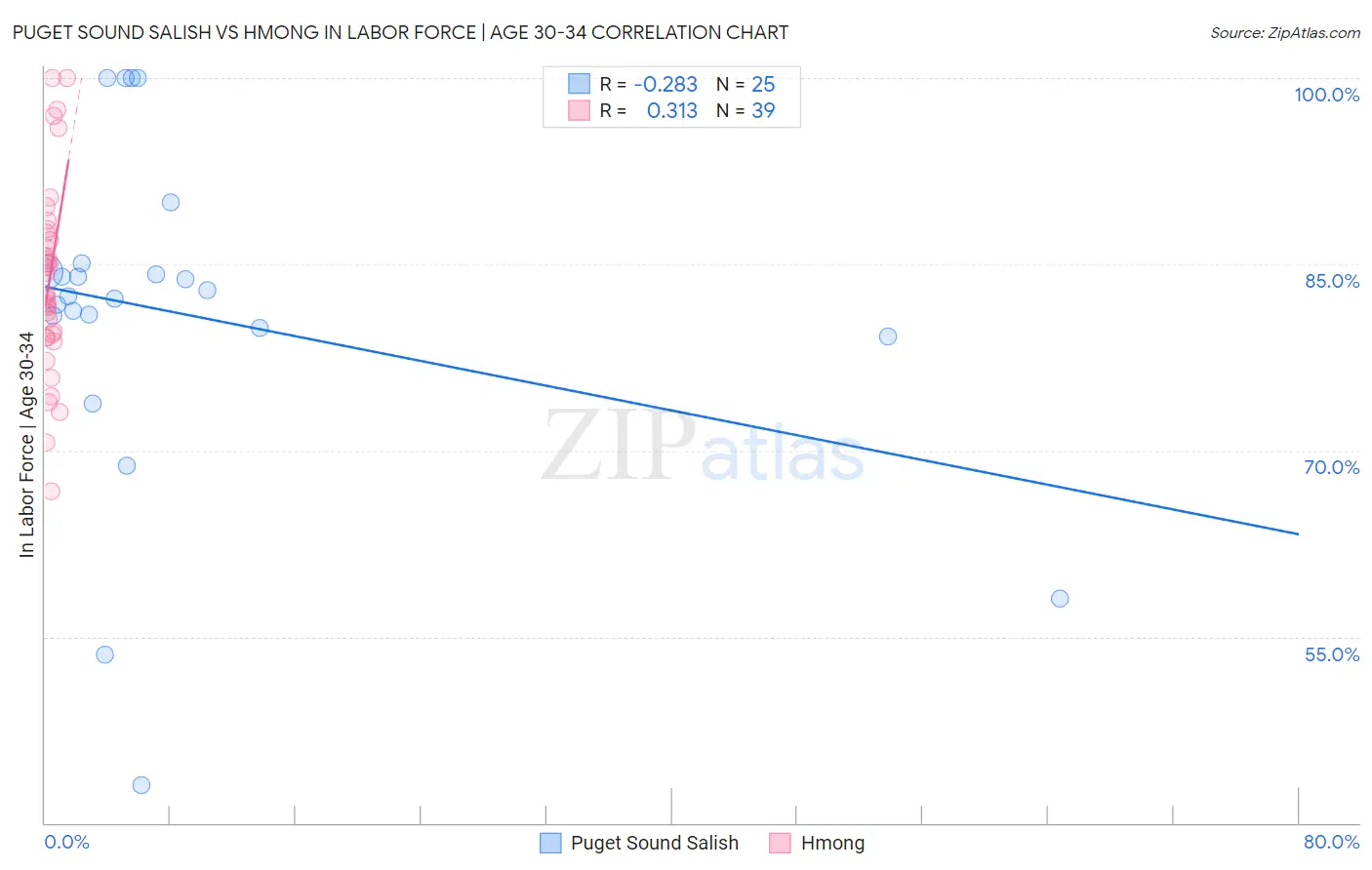Puget Sound Salish vs Hmong In Labor Force | Age 30-34
COMPARE
Puget Sound Salish
Hmong
In Labor Force | Age 30-34
In Labor Force | Age 30-34 Comparison
Puget Sound Salish
Hmong
82.1%
IN LABOR FORCE | AGE 30-34
0.0/ 100
METRIC RATING
308th/ 347
METRIC RANK
82.4%
IN LABOR FORCE | AGE 30-34
0.0/ 100
METRIC RATING
300th/ 347
METRIC RANK
Puget Sound Salish vs Hmong In Labor Force | Age 30-34 Correlation Chart
The statistical analysis conducted on geographies consisting of 46,152,160 people shows a weak negative correlation between the proportion of Puget Sound Salish and labor force participation rate among population between the ages 30 and 34 in the United States with a correlation coefficient (R) of -0.283 and weighted average of 82.1%. Similarly, the statistical analysis conducted on geographies consisting of 24,678,157 people shows a mild positive correlation between the proportion of Hmong and labor force participation rate among population between the ages 30 and 34 in the United States with a correlation coefficient (R) of 0.313 and weighted average of 82.4%, a difference of 0.38%.

In Labor Force | Age 30-34 Correlation Summary
| Measurement | Puget Sound Salish | Hmong |
| Minimum | 43.0% | 66.7% |
| Maximum | 100.0% | 100.0% |
| Range | 57.0% | 33.3% |
| Mean | 81.0% | 83.7% |
| Median | 82.4% | 82.6% |
| Interquartile 25% (IQ1) | 79.5% | 79.1% |
| Interquartile 75% (IQ3) | 84.7% | 87.5% |
| Interquartile Range (IQR) | 5.2% | 8.4% |
| Standard Deviation (Sample) | 13.7% | 7.6% |
| Standard Deviation (Population) | 13.5% | 7.5% |
Demographics Similar to Puget Sound Salish and Hmong by In Labor Force | Age 30-34
In terms of in labor force | age 30-34, the demographic groups most similar to Puget Sound Salish are Menominee (82.2%, a difference of 0.10%), Spanish American Indian (82.2%, a difference of 0.16%), Immigrants from Mexico (82.0%, a difference of 0.16%), Osage (82.3%, a difference of 0.17%), and Cajun (82.0%, a difference of 0.19%). Similarly, the demographic groups most similar to Hmong are Hispanic or Latino (82.4%, a difference of 0.010%), Ottawa (82.4%, a difference of 0.040%), Immigrants from Micronesia (82.4%, a difference of 0.050%), Immigrants from Central America (82.5%, a difference of 0.060%), and Tlingit-Haida (82.3%, a difference of 0.13%).
| Demographics | Rating | Rank | In Labor Force | Age 30-34 |
| Americans | 0.0 /100 | #294 | Tragic 82.7% |
| Pennsylvania Germans | 0.0 /100 | #295 | Tragic 82.6% |
| Chippewa | 0.0 /100 | #296 | Tragic 82.6% |
| Comanche | 0.0 /100 | #297 | Tragic 82.6% |
| Aleuts | 0.0 /100 | #298 | Tragic 82.6% |
| Immigrants | Central America | 0.0 /100 | #299 | Tragic 82.5% |
| Hmong | 0.0 /100 | #300 | Tragic 82.4% |
| Hispanics or Latinos | 0.0 /100 | #301 | Tragic 82.4% |
| Ottawa | 0.0 /100 | #302 | Tragic 82.4% |
| Immigrants | Micronesia | 0.0 /100 | #303 | Tragic 82.4% |
| Tlingit-Haida | 0.0 /100 | #304 | Tragic 82.3% |
| Osage | 0.0 /100 | #305 | Tragic 82.3% |
| Spanish American Indians | 0.0 /100 | #306 | Tragic 82.2% |
| Menominee | 0.0 /100 | #307 | Tragic 82.2% |
| Puget Sound Salish | 0.0 /100 | #308 | Tragic 82.1% |
| Immigrants | Mexico | 0.0 /100 | #309 | Tragic 82.0% |
| Cajuns | 0.0 /100 | #310 | Tragic 82.0% |
| Chickasaw | 0.0 /100 | #311 | Tragic 81.9% |
| Mexicans | 0.0 /100 | #312 | Tragic 81.9% |
| Iroquois | 0.0 /100 | #313 | Tragic 81.9% |
| Alaskan Athabascans | 0.0 /100 | #314 | Tragic 81.7% |